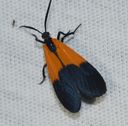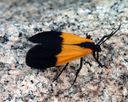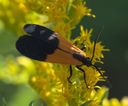Hodges#8087
Lycomorpha pholus
Classification
- Phylum: Arthropoda
- Subphylum: Hexapoda
- Class: Insecta
- Order: Lepidoptera
- Superfamily: Noctuoidea
- Family: Erebidae
- Subfamily: Arctiinae
- Tribe: Lithosiini
- Subtribe: Cisthenina
- Genus: Lycomorpha
- Species: pholus
Pronunciation
How to pronounce Lycomorpha pholus: /ˌlaɪkoʊˈmɔrfə ˈfoʊləs/
These audio files are automatically generated. While they are not always 100% accurate, they are a good starting point.
Images






Summary
Lycomorpha pholus, commonly known as the black-and-yellow lichen moth, is found across North America primarily in habitats with lichen availability. The moth exhibits a distinctive color pattern and serves a role in its ecosystem related to lichen consumption.
Physical Characteristics
Wingspan 25-32 mm; body length about 10 mm. Adult body and wings bluish-black with a basal portion of wings yellow, orange, or red; distal portion of wings black. Variability in color exists. Larva gray dotted with pale green and sparse long hairs.
Identification Tips
The adult moth can be recognized by its bluish-black body and wings with variable yellow/orange/red coloration at the basal portion.
Habitat
Short-grass prairie and areas where lichens are present.
Distribution
Eastern North America to the Rockies, Alberta south to New Mexico and from Nova Scotia to North Carolina, west to South Dakota and Texas.
Diet
Larvae feed on lichens.
Life Cycle
Development may take several years, particularly in northern regions.
Ecosystem Role
Plays a role in the ecosystem as a consumer of lichens and as a potential mimicry model for predators.
Evolution
Part of the large and diverse family Erebidae within the order Lepidoptera.
Similar Taxa
Misconceptions
The red color pattern on some specimens is often misinterpreted as poisonous; however, it is thought to serve as a mimicry for Lycid beetles.
Tags
- moth
- Erebidae
- Lepidoptera
- North America
- lichen feeder